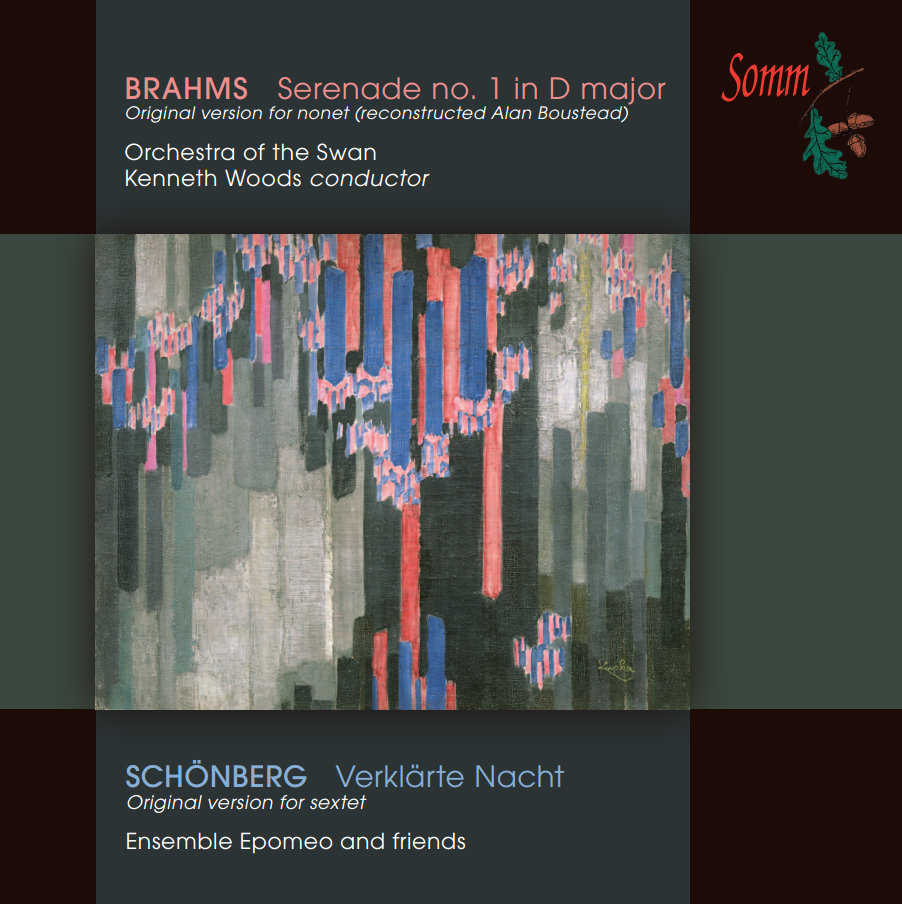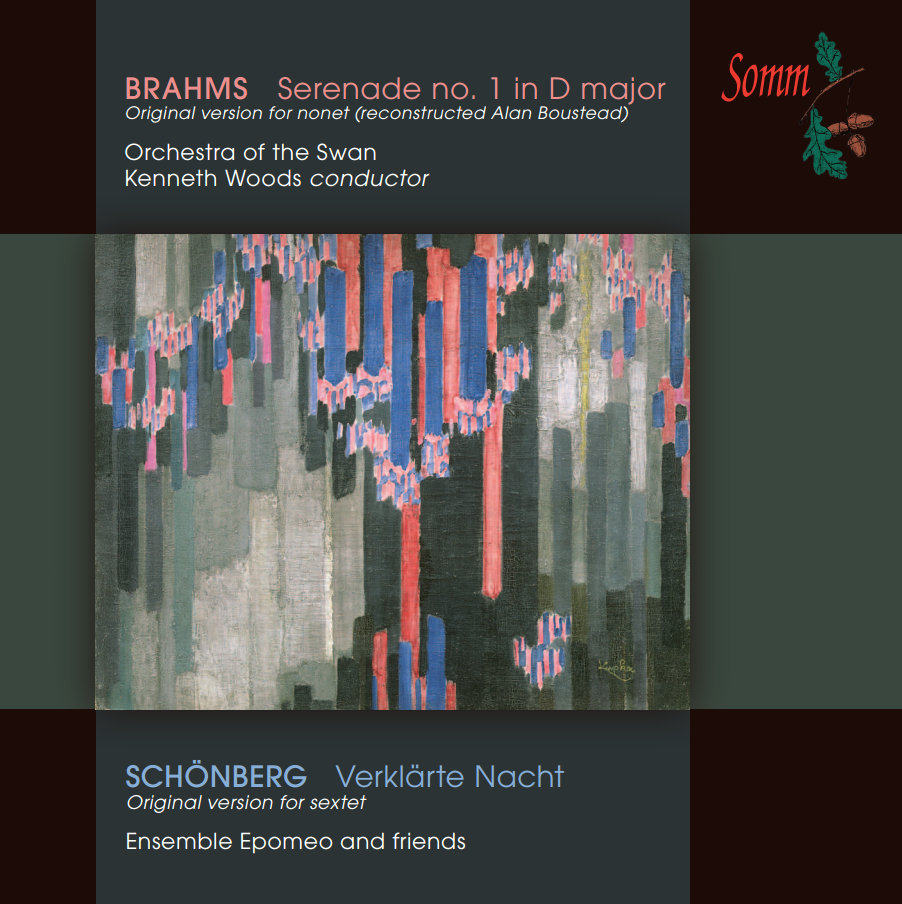[Click here to Explore the Score of the companion work on this CD, Schoenberg’s Verklarte Nacht]
The Brahms-Wagner rivalry was largely an affair of the press, whipped up by critics like the Brahmsian Eduard Hanslick and his pro-Wagnerian rivals. Brahms actually professed great admiration for Wagner’s music on many occasions. Nonetheless, there was a time when the two men were perceived as embodying irreconcilable aesthetic approaches. In the end, it was Arnold Schönberg who succeeded in Verklärte Nacht and the works which followed it, in marrying the joint influences of Wagner and Brahms as no one had before.
Brahms’s music- its density, richness and rigour- had a profound influence on Arnold Schönberg’s development, and his engagement with Brahms’s music continued throughout his career. Schönberg’s writings about the music of Brahms, particularly his essay “Brahms the Progressive,” are among the most illuminating analyses of the older composer’s work, and his arrangement of Brahms’s Piano Quartet in G minor for full orchestra has become a staple of the orchestral repertoire. From Brahms, Schönberg learned the creative possibilities of the perpetual manipulation and development of tiny motivic cells, an approach that would eventually form the underpinning of the 12-tone technique. This kind of rigorously detailed approach to composition is already fully developed in Verklärte Nacht. Brahms’s favourite technique of “developing variation” (a term coined by Schönberg which refers to the constant development of small musical ideas throughout a piece) is also essential in Schönberg’s music. Brahms’s approach to most classical forms differs from that of his forerunners in that Brahms’s music is almost never simply expository nor recapitulatory: the musical material starts to develop and evolve almost as soon as the piece starts, and the process of constant change carries right through to the end.
Brahms’s Serenade in D major, opus 11, written when the composer was 25, is a symphony in all but name, and was the composers’ first major orchestral work. It embodies the full range of his mature compositional voice. Brahms originally conceived the piece as a four-movement work for nonet (the two Scherzi were added when the piece was re-orchestrated). before expanding on the advice of his friend Joseph Joachim who conducted the successful premiere of the nonet version in 1958. Joachim also encouraged Brahms to consider designating the work as his first symphony, and for much of the work’s evolution the two friends referred to the piece as Brahms’s “Symphony-Sereade.” However, once the two scherzo’s were added, Brahms felt the piece was definitely not “symphonic,” and stuck with the designation of “Serenade,” a decision which has no doubt contributed to the relative neglect of this glorious work. Brahms destroyed his nonet version, but in the 1980’s Alan Boustead reconstructed the lost original version of this work for solo strings, flute, two clarinets, bassoon and horn. One hopes Brahms would approve- he did later sanction publication of variant versions of the Haydn Variations for both orchestra and piano duo, and of the F minor Piano Quintet, which also exists in a version two pianos.
Brahms’s music is full of references to the music of his forbearers, something that is easy to miss because his own stylistic imprint is so strong. Brahms’s D major Serenade begins in folksy style:
This is an almost-direct quote from Haydn’s final symphony, no. 104 (also in D major)
And the opening Allegro molto contains several references to the first movement of Beethoven’s Pastoral Symphony:
The connection to Haydn’s rustic finale and Beethoven’s evocation of rural nature is no accident- D major is Brahms’s “outdoor” key, and his later D major Symphony no. 2 and the Violin Concerto would also be full of the sounds of the countryside, from hunting horns to folk dance.
(It is also no accident that the sunny D Major morning of the Serenade is immediately preceded on this disc by Schönberg’s radiant depiction of dawn in the same key).
The first scherzo is shadowy and dark:
Relieved briefly by a warm-hearted and rustic trio:
The heart of the Serenade is the wonderful and deeply spiritual Adagio. It is the longest and most ambitious slow movement in Brahms’s orchestral music- grander than the slow movements of any of the symphonies. The great musicologist Michael Steinberg asked of this movement “what is such transcendence doing in a serenade?” before pointing us to Mozart’s own transcendent serenades by way of an answer.
Could one hear echoes in this movement of the slow movement of Beethoven’s last symphony?
The two Menuetti are gentle, inward-facing intermezzi:
The wistful mood will be familiar to anyone who knows the third movements of the first three Brahms symphonies. Here’s the Allegretto from the Second Symphony
The tune of the second minuet is described by Steinberg as “one of the most tenderly expressive of Brahms’s whole life.”
The second Scherzo, however, is extrovert and virtuosic:
With a gregarious quote from Handel’s Messiah thrown in for good measure.
The Serenade’s Finale, like those in so many of Brahms’s D major works, hints at gypsy music and evokes a decidedly rustic atmosphere with its driving dotted rhythms.
The final pages are ecstatically joyful and exuberant. Symphonic? Maybe not, but echt-Brahmsian in every way.
— c. 2014 Kenneth Woods


Who publishes the reconstruction, and where can I get my hands on a copy?
The reconstruction is only available on hire from Josef Weinberger Ltd in London. Too bad indeed!
The sets of parts and scores of the Nonet reconstruction can be purchased in several, at least three, different publications.